What's in bloom in July Wildflowers in our region that bloom in July. Weeds! Click here
This is a quick guide to some of wildflowers you might see in bloom in our region in July. Do a web search on each plant for larger photos and detailed information. Blooming happens latter in the north and at higher altitude.
If you know of a flowering wild plant that is missing, contact webkeeper@amcdv.org.
All photos are in the commons for non-commercial use, as is the information on this page.
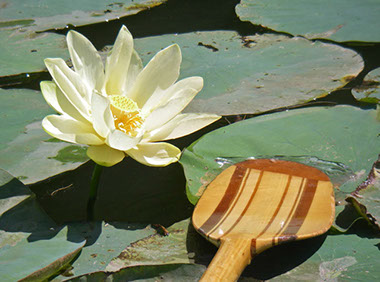
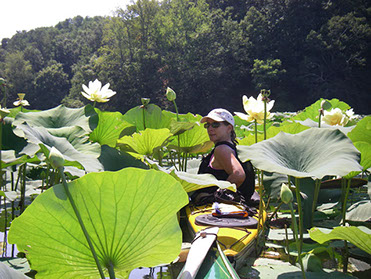
American Lotus, Nelumbo lutea, the largest flower native to North America and one of the largest in the world. Flowers bigger than your head! Definitely not a water lily, it's the closest living relative of the sycamore tree. Blooms July through fall.
Click here to learn more about this amazing plant and where to see it.

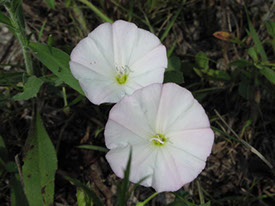
Field Bindweed (above), Convolvulus arvensis. Introduced in the mid 1700s as a crop seed contaminant. Blooms June through fall. This is wild morning glory, so the flowers will close and wither as the day progresses. Flowers that range from pure white to heavily colored or streaked with pink and lavender.
Field Bindweed is distinguished from Hedge Bindweed, Convolvulus sepium, (below) not only by where it choosed to grow, but by the leaves. The plants have three lobed leaves. The base lobes, those closest to the stem, are pointy on the Field Bindweed while those on the Hedge Bindweed are blunt.

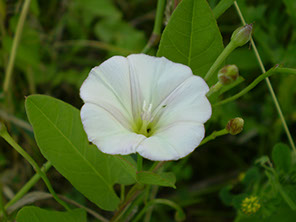
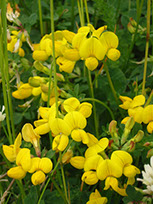
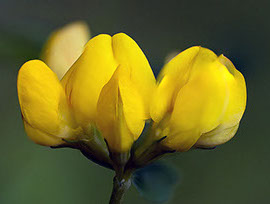
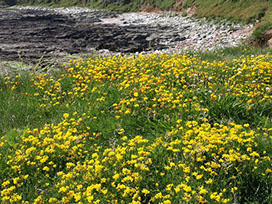
Birdsfoot Trefoil, Lotus corniculatus, Eurasian native widely grown as a forage crop. A pea family member that fixes nitrogen, withstands close grazing and is good for livestock.
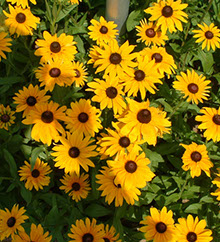

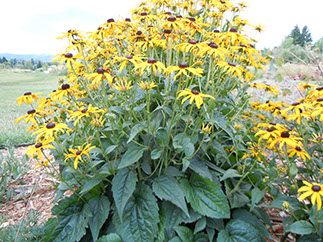
Blackeyed Susan, Rudbeckia hirta, North American native that blooms July into fall. It is an annual that likes moist meadows and woodland verges. Flowers are up to four inches across. The state flower of Maryland.
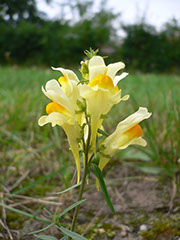
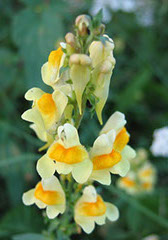
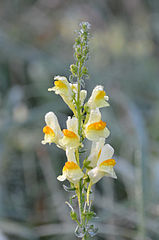
Butter and Eggs, Yellow Toadflax, Linaria vulgars, a Eurasian native and relative of the snapdragon, brought to this country as a garden plant, it has escaped and grows wild across all of North America. This perennial favors well-drained disturbed soils and sunny locations, and produces long-lasting cut flowers. Blooms late July through frost in our area.
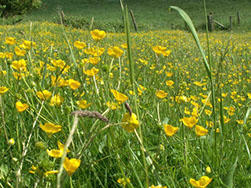

Buttercups, Ranunculus species. Many species of buttercups may found in our area, some native some not. Most bloom spring through fall.
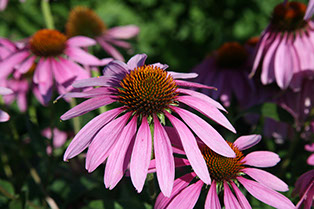

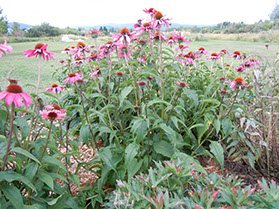
Eastern Purple Coneflower, Echinacea purpurea, an attractive native bloom long used for medicinal purposes by both American Indians and European settlers.
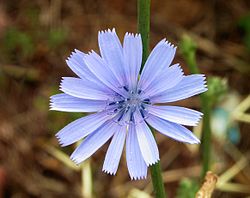
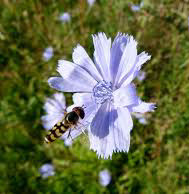

Chicory or Cornflower, Cichorium intybus, a European native naturalized across all of North America. Blooms July through fall. The wild version of the plant cultivated for salad greens, Belgian endive and whose roots are used as a coffee additive or substitute.
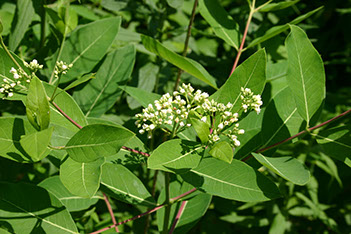
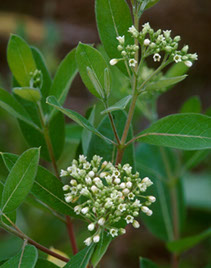
Dogbane, Indian Hemp, Apocynum cannabinum, is a perennial herb native to most of North America. It is highly toxic if eaten, and is a hazard for grazing livestock. It is found in open medows and woodland verges. The cannabinum in its name refers to the similarity to the hemp fiber plant, and it contains no psychoactive drug. Blooms Julne to August. Attracts butterflies.
1.jpg?crc=240919899)
3-crop-u15546.jpg?crc=4284324365)
2.jpg?crc=330717236)
Daisy Fleabane, Erigeron annuus. Also Philadelphia Fleabane, Erigeron philadelphicus, Both look nearly the same, but the latter plant has leaves that closly clasp the stem. Both bloom May well into fall.



Oxeye Daisy, Leucanthemum vulgare, syn. Chrysanthemum leucanthemum. Eurasian native now found in all US states and Canadian provinces. Blooms from late May throughout summer.
1-crop-u15582.jpg?crc=390019689)
4-crop-u15577.jpg?crc=11700268)
.jpg?crc=4282645095)
Golden Ragwort, Senecio aureus. Blooms April through July. Native to eastern North America. The flowers are about a half inch across.
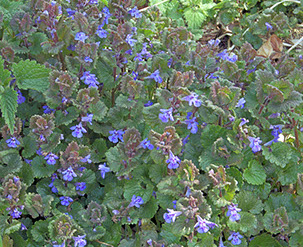
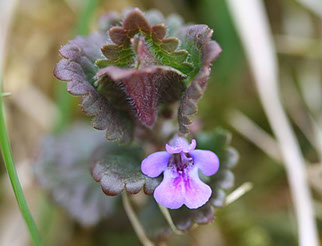
Ground Ivy, Glechoma hederacea, naturalized native of Europe and parts of Asia. Blooms May to July. Tiny flowers and lobed leaves.

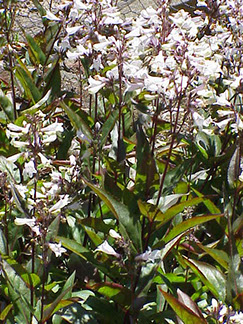

Foxglove Beardtongue, Penstemon digitalis, a perennial native to much of eastern North America. Blooms June into July.
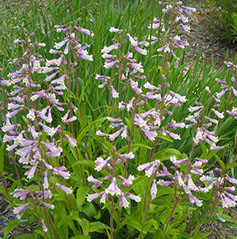
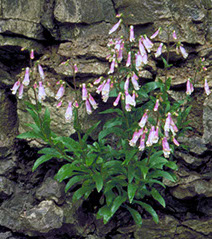
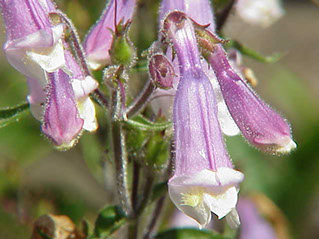
Hairy Beardtongue, Penstemon hirsutus, native to most of eastern North America, except for the far south. Blooms June into July.

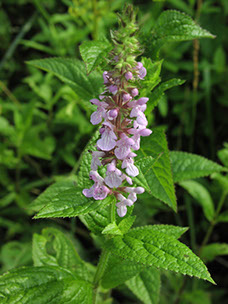
Hedge-Nettle, Stachys tenuifolia, is a member of the mint family, a perennial native to eastern North America that blooms in July and August. One sniff of the plant will clearly indicate its mint family membership. Varities and sub-species are known as the rough hedge nettle, the smooth hedge nettle and the hairy hedge nettle. Variants and synonyms include Stachys glabra, Stachys hispida, Stachys palustris var. hispida, Stachys palustris var. macrocalyx, Stachys tenuifolia var. hispida, Stachys tenuifolia var. perlonga, Stachys tenuifolia var. platyphylla. The plant can grow five foot tall or higher.
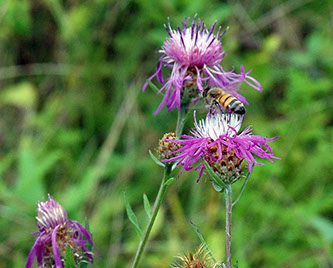

Ironweed: Vernonia gigantia, Vernonia altissima (tall Ironweed, Vernonia noveboracensis, (New York Ironweed) and several other similar and related species are native to eastern North America and prefer moist to damp meadows. They are all related to sunflowers. Altissima can reach 10 foot tall!
,

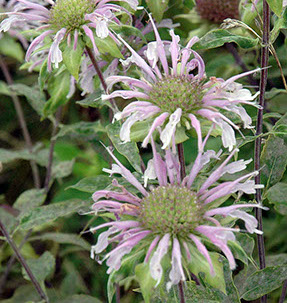
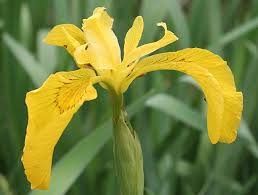


Wild Iris, members of the family Iris, which has more than 200 species. Named after the ancient Greek goddess of the rainbow, these showy flowers come in a wide range of colors. A native perennial plant, the wild ones bloom June into July.
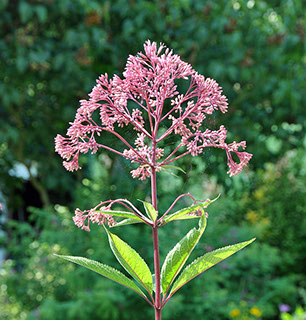
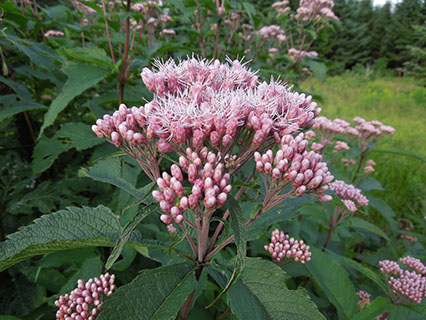
Joe Pye Weed, Eutrochium maculatum, is native to northeastern and north central North America as far south as Kentucky. This perennial grows as tall a five or six feet, and favors moist to wet soil and full sun. Its native habitate is marshes, but it does well in roadside drainage ditches. In our area, blooms late July into fall.

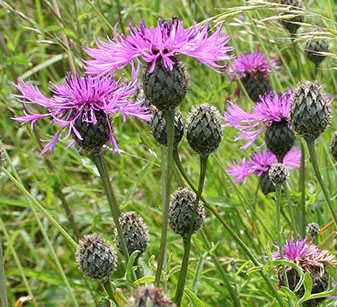
Black Knapweed, Centaurea nigra, a perennial of Eurasian origin that blooms in late summer and fall. The base of the flower is dark. There is also a Brown Knapweed, with a lighter brown flower base.
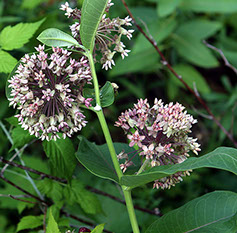
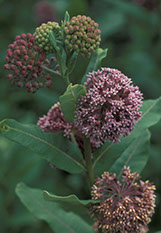
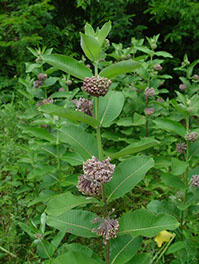
Common Milkweed, Asclepias syriaca, a native plant that is one of 140 species of milkweed, the sole food of monarch butterflies and their larvae, and food for many other creatures. Beautiful, fragrant flowers bloom in mid to late June into July. A perennial found in open fields. Valley Forge Park is a great place to see it.
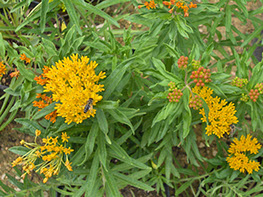
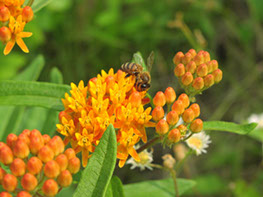
Orange Milkweed or Butterfly Milkweed, Asclepias tuberosa, A native species whose beautiful flowers bloom in mid to late June into July. A perennial found in open fields.


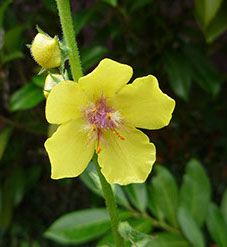
Moth Mullein, Verbascum blattaria, naturalized or invasive native of Eurasia and north Africa. May be white, yellow or shades between.

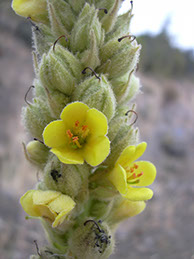

Common Mullein Verbascum thapsis, a biannual Eurasian native brought to North America as a medicinal plant. The plants grow spikes three to five feet high. Blooms July through September.
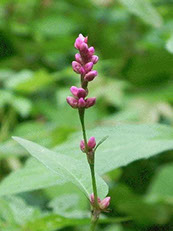
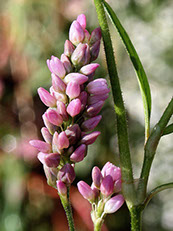
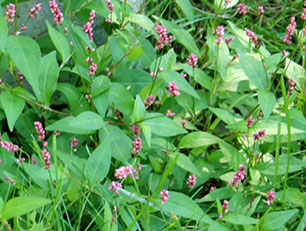
Pennsylvania Smartweed or Knotweed, Polygonum pensylvanicum, a eastern North American native, member of the buckwheat family. Smooth edged eaves about an inch long, pinhead sized buds in elongated clusters, tiny flowers. Major food source for birds. Blooms throughout summer.
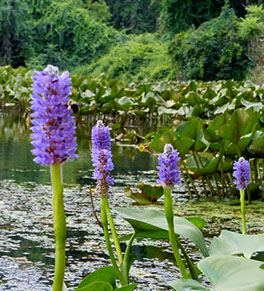
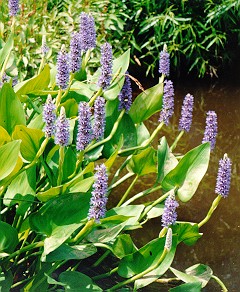
Pickerel Weed, Pontederia cordata, is a perennial emergent aqyatic native to the eastern Americas from Canada to Argentina. It likes full sun and quiet water, and so grows along lake, pond and marsh edges. It grows about four feet high, with the bottom rwo feet underwater. Blooms June through fall in our area.
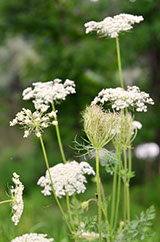

Queen Anne's Lace, Daucus carota, native of Europe, now found worldwide. May or may not have a tiny red flower in the center. The wild ancestor of the carrot. Pull one and look at and smell the root.

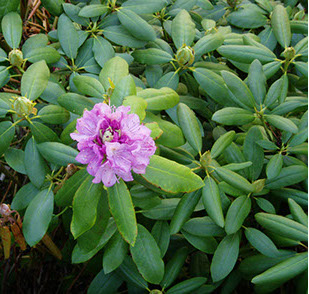
Rhododendron, also called Giant Rhododendron, Rhododendron maximum, the species of rhododendron native to the Appalachian Mountains from Maine to Georgia. It produces large white to purple flowers that in our region bloom from very late June well into July. The plants can grow to 15 foot or taller.
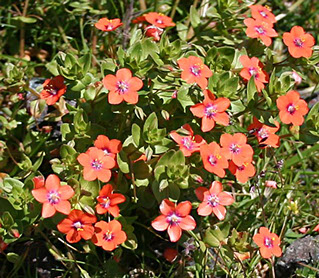
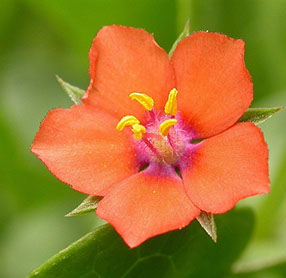
Scarlet Pimpernel, Anagallis arvensis, an annual native of Europe, Western Asia, North Africa and possibly parts of North America, now naturalized worldwide. This low growing plant does well in poor soil. Blooms June through September in our area. The flowers, which are samller than a dime, open only in direct sunlight.
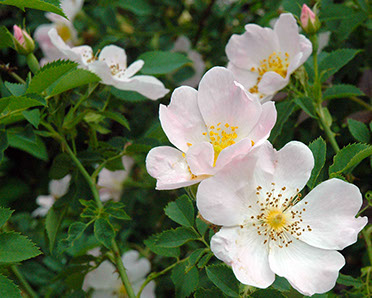
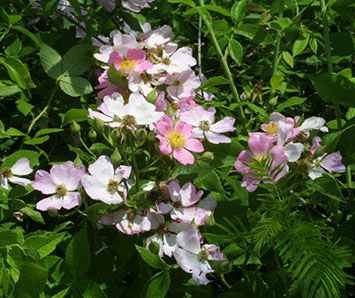
Native wild roses: The Virginia Rose, Rosa virginiana (left) , and the Field Rose, Rosa arvensis. Both are perennials native to eastern North America. The former is a bush or shrub that likes full sun and has many thorns, and may grow to six feet or more tall. The latter prefers woodland verges and field edges and climbs on other plants and fences, and has far fewer thorns. Both have white to pink flowers with five petals about two inches across. Both bloom late May through most of summer, and produce bright red rose hips.

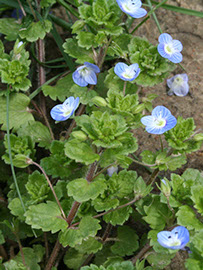
Speedwell, Persian Speedwell, Birdseye Speedwell, Veronica persica, is a seed propagated annual native to Eurasia found throughout North America. Blooms April to August with very tiny flowers less than a quarter inch across.


Trumpet Creeper, Campsis radicans, a perennial vine native to eastern North America. This aggressive climber attaches to trees, fences walls and can grow to more than 30 feet high. The beautiful waxy flowers almost four inches long attract hummingbirds. Blooms late July into September in our area.
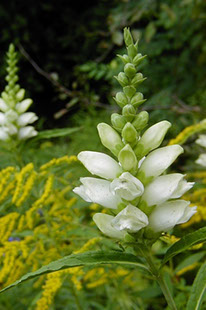


Turtlehead, Chelone glabra, is a perennial native to eastern North America from Canada almost to the Gulf Coast. Grows along river banks and in wetlands, and grows from one to four foot tall before blooming. Flowers from late July into September. A favorite food of deer.

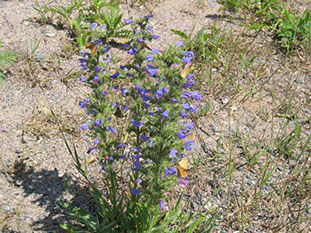
Viper's Bugloss or Blueweed, Echium vulgare, a biannual European native naturalized throughout most of North America. Sometimes grown as an oilseed plant. Grows in open areas and thrives in poor soil.

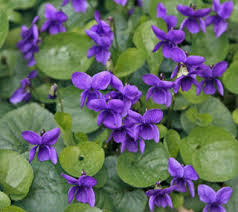
Violets, Viola sororia, synonym Viola papilionacea. State flower of New Jersey.


Sweet White Violet, Viola blanda
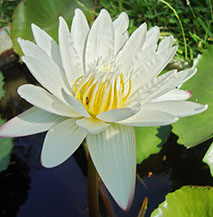

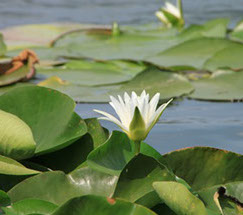
Water Lily, Nymphaea odorata, a native plant found in the shallow parts of lakes and ponds from central America to northern Canada. Blooms July through fall.
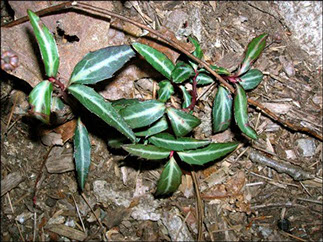

Striped Wintergreen or Spotted Wintergreen, Chimaphila maculata, native to eastern North America south through Central America. Blooms late June through August. You will likely spot the leaves before you see the flowers.
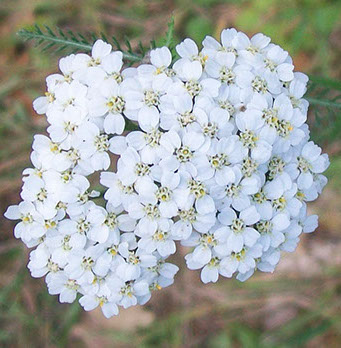
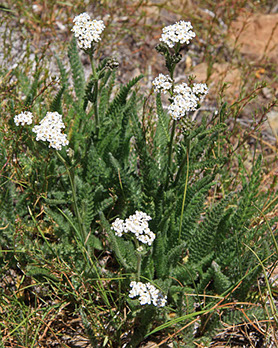
Yarrow, Achillea millefolium, is a perennial native to all parts of the northern hemisphere. In North America, it is a complex of both native and introduced plants and their hybrids. Botanically, it is either treated as ons species with several varities or as several species or sub-species. It grows to three foot tall with a single stem that does not branch except near the top, Blooms June through September.
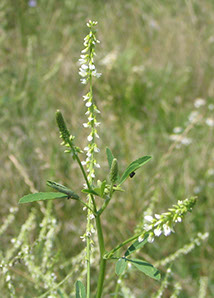
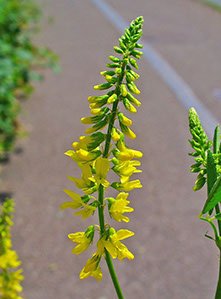
Problem invasive? White Sweet Clover, Melilotus albus, and Yellow Sweet Clover, Melilotus officinalis; also called white or yellow melilot. First imported from Europe as a forage crop in the 1600s, it has spread across almost all of North America and crowds out native species. A biannual that fixes nitrogen, thrives in poor soil and needs lots of sun. Often found along roads and railroads, in vacant lots and disturbed soil.
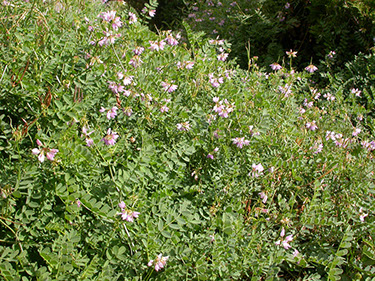
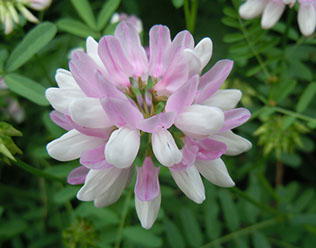
Problem invasive? Crown Vetch, Coronilla varia, is a nitrogen-fixing Eurasian native of the pea family widely used for erosion control since the 1950s. It was once extensively planted along highway cuts and embankments, but it's use has declined since it attracts deer, who like to eat it, and it is sensitive to the herbicides overused by some agencies (e.g., PA Turnpike Commission). Also planted as green manure crop to improve soil. Crowds out native vegetation. Blooms from June throughout summer.
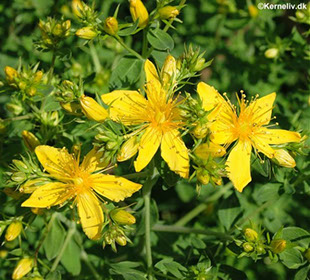
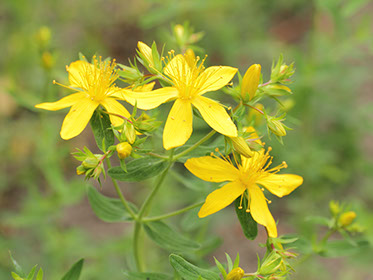
Toxic invasive, St. John's Wort, Hypericum perforatum, is a perennial herb native to Eurasia and North Africa, that is poisonous to grazing livestock. It is now naturalized across North America. Blooms July through August.
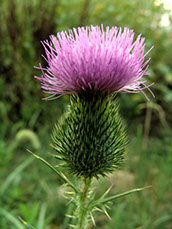

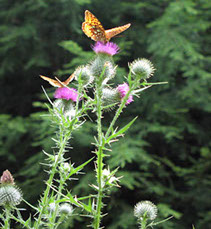
Problem invasive species: Bull Thistle, Cirsium vulgare, a Eurasian native that is spiny and highly toxic. Somewhat less aggressive and invasive than the Canada Thistle, but still a problem.
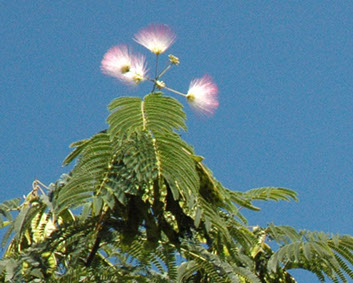
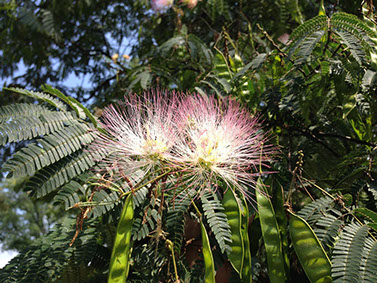
Problem invasive: Mimosa Tree, Albizia julibrissin, Is an Asian import, often planted for its beautiful flowers and foliage. It now grows wild in the US south of Massachusetts. It often bears seeds and flowers at the same time. Breeders are attempting to produce a seedless tree to make it more suitable for ornamental planting. It is fast growing small tree that is often a pioneer species in vacant lots and disturbed soils. Its main problem is that it displaces native species. Fortunately, it is plagued by fungal diseases in the eastern US, which keep it somewhat under control. Blooms summer through early fall.
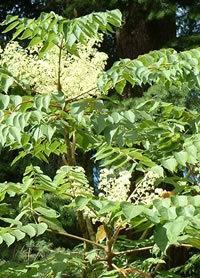
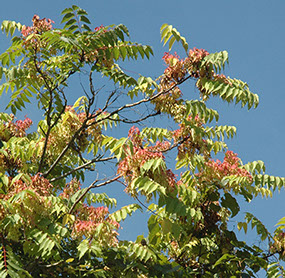
Problem invasive: Japanese Angelica Tree, Aralia elata, a native of east Asia first imported as a garden ornamental, now escaped and listed as a problem invasive by the National Park Service, the US Forest Service and many states in the mid-Atlantic region.Larger than the native Aralia spinosa. White flowers in July give way to orange seed clusters in August.
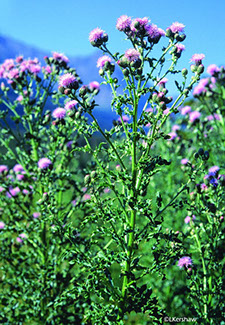
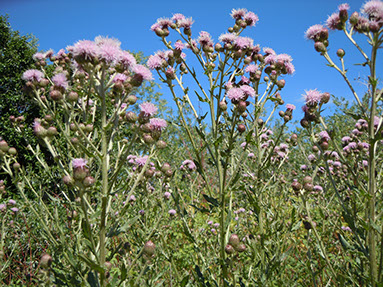
Problem invasive species: Canada Thistle, Cirsium arvense, It is from Europe, not Canada. Its prickly leaves make pasture and silage grasses inedible to livestock, and a field of these is nearly impassible to hikers. Likes sun, and crowds out native vegetation. Dime to nickle sized flowers, many on a stalk, distinguish it from the larger-flowered bull thistle. In most of our area, this will be don blooming by early July.

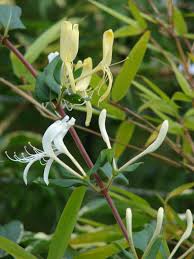
Problem invasive species: Japanese Honeysuckle, or just Honeysuckle, Lonicera japonica. Indigenous to Japan and Korea, it crowds out native vegitation and kills young trees by girdling them. It has a big flush of flowers in June, then continues blooming but with fewer flowers through summer, more so in sunny locations.

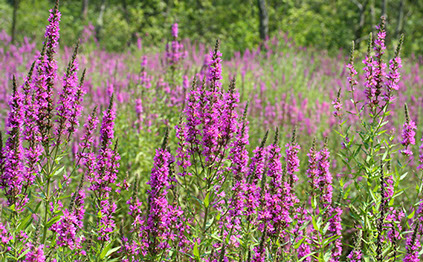
Problem invasive species: Purple Loosestrife, Lythrum salicaria, is a flowering plant native to Europe, Asia and northwest Africa. It arrived here by the early nineteenth century as a seed contaminant, with ship ballast and as a medicinal plant. It displaces native plants that offer much more food and shelter to wildlife. It inhabits wetlands and has spread across North America, often following canals and drainage ditches along roads. Click here to read more about this pest and its control.
